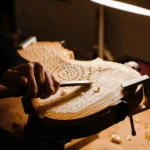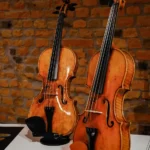How Much Does a Violin Cost?
Back to BlogPlaying the violin is a captivating journey that intertwines skill, passion, and artistry. As you dive into the world of musical instruments, you’ll inevitably come across discussions about violin prices. Have you ever wondered how much a violin costs? From the affordable beginner violins that cost thousand of euros, to the inspiring multimillion-euro masterpieces crafted by renowned violin makers. The price range in the violin market is vast.
In this blog post, we will explore the factors that influence the cost of violins, delve into different price ranges, and provide insights into finding the right violin that is within your budget. Whether you’re a beginner embarking on your musical journey or a professional violinist seeking a professional-grade instrument, understanding the violin market and its price dynamics will guide you in making informed decisions. So, let’s uncover the mysteries behind violin prices and the various factors that contribute to the cost of these exquisite musical instruments.
How Much Do Violins Cost: Factors Influencing Violin Prices
When it comes to determining the cost of a violin, several key factors come into play. These factors explain to us why violins can range from affordable options to high-end, expensive violins. Let’s explore the factors that contribute to the cost of a violin:
Quality of Materials
The quality of wood used in crafting a violin significantly impacts it’s price. Fine aged tonewoods like spruce for the top of the violin and maple for the back, sides, and neck are highly sought after due to their tonal qualities and traditional usage.
Craftsmanship and Workmanship
The level of skill, expertise, and attention to detail demonstrated by the violin maker influences the instrument’s value. Meticulous hand-carving, precise craftsmanship, and meticulous varnish application contribute to the overall quality and price of the violin. A contemporary violin can start its price as low as 5,000 euros and go up to 100,000 euros, all according to the level of experience, expertise and skill of the maker.
Age, Rarity, and Historical Significance
Old violins, especially those crafted by renowned violin makers from past eras, can command high prices due to their historical significance, rarity, and the stories they carry. Stringed Instruments with a rich provenance and connection to famous musicians also tend to have higher price tags.
Reputation of the Maker
The reputation and legacy of the violin maker play a significant role in determining the instrument’s price. Instruments crafted by renowned violin makers with established pedigrees and esteemed reputations often come with higher price tags.
Market Demand and Supply
Like any commodity, the laws of supply and demand affect violin prices. Limited supply, combined with high demand for instruments from renowned makers or in specific styles, can drive up prices.
Exploring Different Price Ranges
The world of violins offers a wide range of price options to suit various budgets and skill levels. Let’s explore the three main price categories:
Beginner Violins
Price Range: Typically ranging from around $100 to $1,000.
These violins are designed for novice players and students. They provide a solid foundation for learning and are often crafted with more affordable materials to keep costs down. While they may not possess the same tonal complexity as higher-end instruments, beginner violins are perfect for those starting their musical journey.
Intermediate-Level Violins
Price Range: Generally ranging from $1,000 to $5,000.
Intermediate-level violins are a step up in terms of quality and tonal characteristics. They often exhibit better craftsmanship, finer materials, and improved playability. These instruments cater to advancing students and amateur players looking for enhanced sound and responsiveness as they progress in their musical abilities.
Professional Violins and Concert-Level Violins
Price Range: starting from $5,000 up to $30,000
Professional-grade violins are meticulously crafted instruments that offer exceptional tonal qualities, projection, and dynamic range. These instruments are all handmade, crafted by professional luthiers, often inspired by the works of legendary violin makers such as Stradivari, Guarneri del Gesù, and Amati. Professional violinists and soloists seek out these instruments for their exquisite craftsmanship and ability to express the nuances of their artistry.
Top Level Concert Violins and Soloist Level
Price Range: starting from $30,000 up to millions of dollars
These instruments are designed to project effortlessly across large concert halls, offering a rich tonal palette, unparalleled responsiveness, and remarkable dynamic range. Known as “soloist” or “concert” violins, they represent the pinnacle of the violin-making art. Professional violinists and soloists seek out these instruments for their exquisite craftsmanship and ability to express the nuances of their artistry. The prices for these top-level concert violins can vary greatly, reaching into the millions of dollars for the most sought-after masterpieces, which are cherished for their exceptional rarity, tonal beauty, and historical significance.
It’s important to note that price ranges can vary depending on factors such as those described in the above section, the violin maker, the age of the instrument, the region of origin, and other unique characteristics.
Understanding the different price ranges will assist you in aligning your budget and requirements with the appropriate level instrument. In the next section, we will explore additional costs to consider when purchasing a violin, ensuring you have a comprehensive understanding of the investment involved.
Additional Violin Costs to Consider
When budgeting for a violin, it’s important to consider additional costs beyond the instrument itself. Like the violin bow, maintenance and repairs.
Violin Bow
A quality bow is essential for producing a beautiful sound and enhancing your playing experience. Bows can range in price depending on the materials used, craftsmanship, and reputation of the bow maker. It’s advisable to allocate a portion of your budget for a suitable violin bow.
Maintenance and Repairs
Over time, your violin may require routine maintenance, adjustments, or repairs. These costs can include services such as restringing, bridge adjustments, soundpost adjustments, and occasional repairs due to accidental damage or wear.
Remember, investing in quality accessories, maintenance, and repairs is crucial for preserving the longevity and performance of your instrument.
Research and Educate Yourself When Looking for a New Violin
Finding the perfect violin within your budget can be an exciting and rewarding process. By exploring these avenues and seeking professional advice, you can find a reliable and reputable source for your violin purchase, ensuring you acquire an instrument that brings you joy and musical fulfillment. Here are some tips to guide you along the way:
Take the time to research different violin makers, origins, and models. Familiarize yourself with the characteristics and reputation associated with various instruments. This knowledge will empower you to make informed decisions and identify the best options within your budget.
Consult with colleagues, experienced players, or reputable violin experts. Their expertise and insights can provide valuable guidance on which stringed instruments are worth considering within your budget range. They can also assist in assessing the playability and sound quality of different violins.
Spend time playing each instrument to evaluate its sound, responsiveness, and overall playability. This hands-on approach will help you find a violin that resonates with you both musically and physically.
Consider renting a violin or financing options if your budget is limited. Renting a violin initially allows you to explore the instrument without a significant upfront investment. Additionally, inquire about financing options that may be available through violin shops or dealers, which can make higher-quality instruments more accessible within your budget.
In conclusion, the cost of a violin can vary significantly depending on factors such as the quality of materials, craftsmanship, age, reputation of the maker, and market demand. Violins are available across different price ranges, from affordable options for beginners to high-end, professional-grade instruments that can command prices in the millions. It’s important to consider your budget, skill level, and musical goals when searching for the right violin. Remember, finding the perfect violin is not just about the price tag, but also about the instrument’s playability, sound quality, and the emotional connection it evokes. With research, expert guidance, and careful consideration, you can find a violin that matches your budget and brings you joy as you embark on your musical journey.









